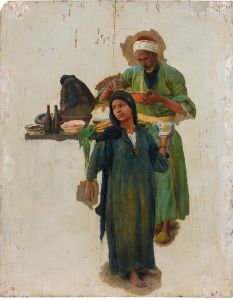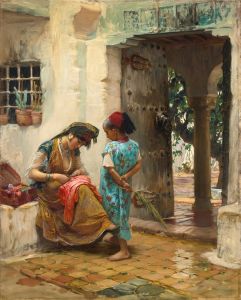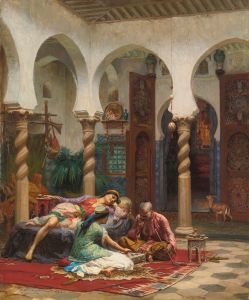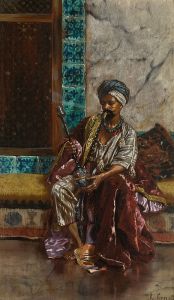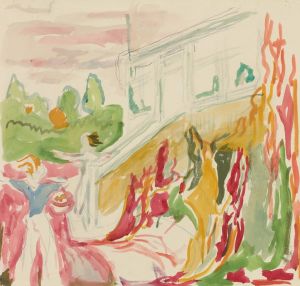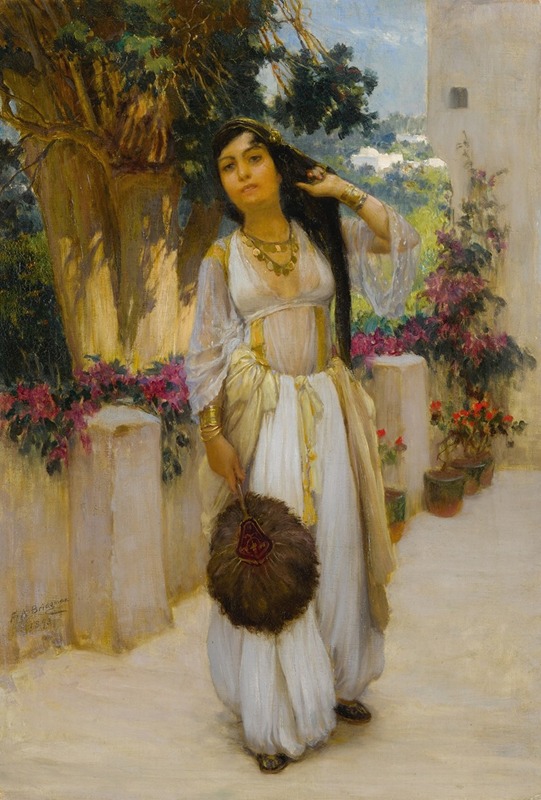
Woman of Algiers on a Veranda
A hand-painted replica of Frederick Arthur Bridgman’s masterpiece Woman of Algiers on a Veranda, meticulously crafted by professional artists to capture the true essence of the original. Each piece is created with museum-quality canvas and rare mineral pigments, carefully painted by experienced artists with delicate brushstrokes and rich, layered colors to perfectly recreate the texture of the original artwork. Unlike machine-printed reproductions, this hand-painted version brings the painting to life, infused with the artist’s emotions and skill in every stroke. Whether for personal collection or home decoration, it instantly elevates the artistic atmosphere of any space.
Frederick Arthur Bridgman, an American artist associated with the Orientalist movement, painted Woman of Algiers on a Veranda in the late 19th century. Bridgman, born in 1847 in Tuskegee, Alabama, was known for his detailed and romanticized depictions of North African and Middle Eastern life, inspired by his extensive travels in the region. He studied art in Paris under Jean-Léon Gérôme, a prominent Orientalist painter, and became one of the most celebrated American Orientalist artists of his time.
Woman of Algiers on a Veranda exemplifies Bridgman’s fascination with the culture and aesthetics of North Africa. The painting portrays a woman seated on a veranda, dressed in traditional Algerian attire. The composition reflects Bridgman’s meticulous attention to detail, particularly in the textiles, architecture, and decorative elements, which were hallmarks of his work. The veranda setting, with its open view and intricate design, suggests a domestic or private space, offering a glimpse into the daily life of the region as imagined by the artist.
Bridgman’s works, including this painting, were influenced by his travels to Algeria and Egypt during the 1870s and 1880s. These journeys allowed him to observe and sketch local people, landscapes, and architecture, which he later incorporated into his studio paintings. However, like many Orientalist works, Woman of Algiers on a Veranda reflects a Western perspective on Eastern cultures, often idealized and filtered through the artist’s imagination rather than presenting an entirely accurate or objective depiction.
The painting is characterized by its warm color palette, soft lighting, and a sense of tranquility. Bridgman’s skill in rendering textures, such as the folds of fabric and the patterns of tiles, is evident in this work. The serene expression of the woman and the intimate setting contribute to the painting’s contemplative mood.
While Woman of Algiers on a Veranda is not as widely known as some of Bridgman’s other works, it remains a representative example of his style and thematic interests. Bridgman’s paintings were well-received during his lifetime, and he exhibited regularly at the Paris Salon and other prestigious venues. Today, his works are held in various public and private collections, though specific details about the current location or ownership of Woman of Algiers on a Veranda are not readily available.
This painting, like much of Bridgman’s oeuvre, continues to be studied as part of the broader Orientalist tradition in 19th-century art, which has been the subject of both admiration and critical reassessment in contemporary scholarship.






